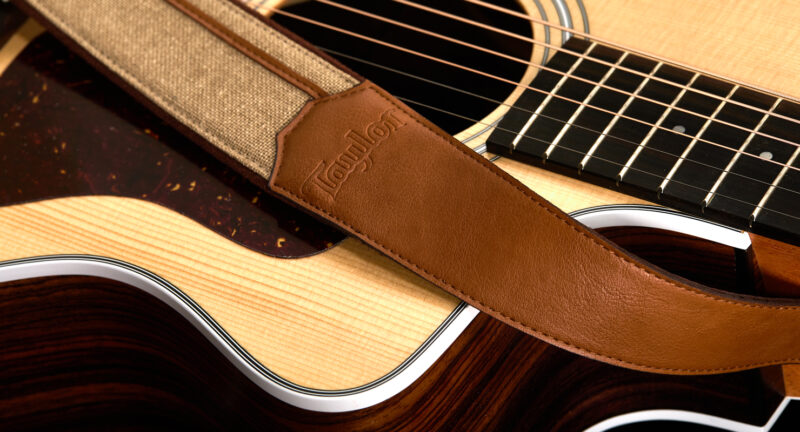If you’re a guitarist, you know the importance of having a comfortable and secure way to hold your acoustic guitar while playing. A guitar strap is a simple yet essential accessory that can make a world of difference in your playing experience.
Whether you’re a beginner or an experienced guitarist, learning how to put a strap on an acoustic guitar is a fundamental skill that will enhance your performance and comfort.
In this comprehensive guide, we’ll walk you through the process step by step, ensuring you have all the knowledge you need to attach your strap like a pro.
Step-by-step Guide
Attaching a guitar strap might seem straightforward, but there are some nuances to ensure your instrument is both secure and comfortable while playing. Here’s how to do it:
Step 1: Locate the Strap Pins
Most acoustic guitars have two strap pins—one at the base of the body and one at the top, near the neck. These pins are designed to hold the straps securely in place.
Step 2: Connect the Strap to the Bottom Pin
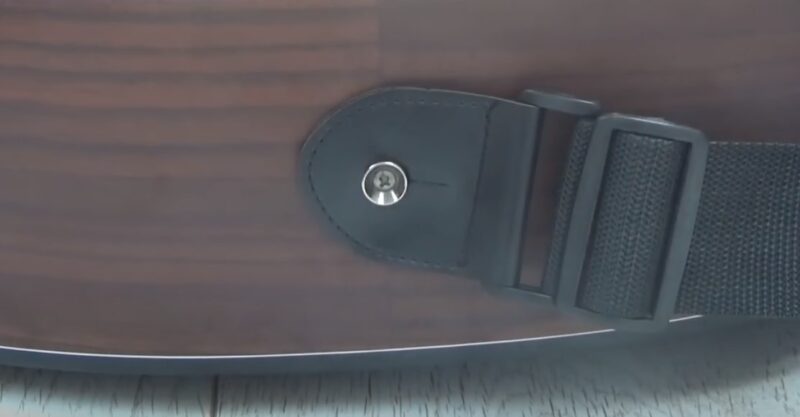
Take the end of your strap with the hole or attachment mechanism and thread it through the bottom pin from the back to the front. Pull it through until it’s secure, ensuring there are no twists or tangles.
Step 3: Attach the Strap to the Top Pin
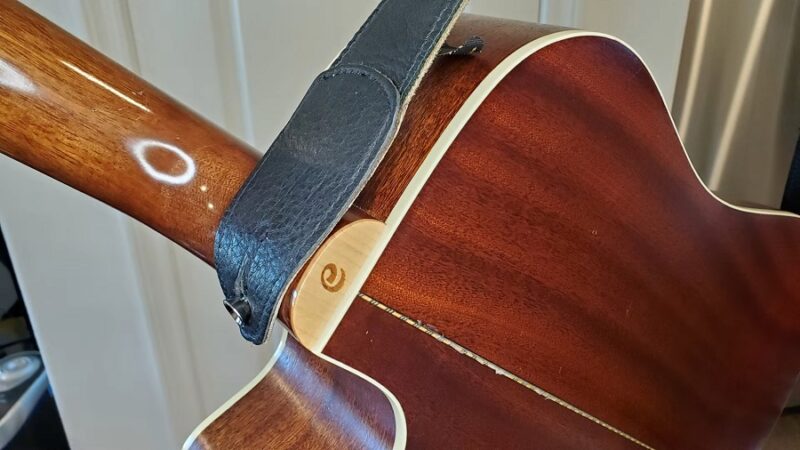
Hold your guitar in the playing position, with the neck pointing upward. Slide the other end of the strap (the wider end without the attachment mechanism) over your shoulder and across your back. The front of it should be facing outward.
With your playing hand, reach behind your back and locate the top pin. Slide the end of the strap through the top pin, again from back to front. Pull it through until it’s snug but not too tight. You want some flexibility for comfortable playing.
And…That’s It!
Congratulations! You’ve successfully attached your guitar strap. Now, let’s make sure it’s adjusted to your liking and explore some additional tips for a comfortable playing experience.
Types of Guitar Straps
These straps come in various materials, styles, and lengths, catering to different preferences and playing styles.
| Type of Guitar Strap | Characteristics | Ideal Use |
|---|---|---|
| Nylon Straps |
|
A popular choice for beginners |
| Leather Straps |
|
Classic look |
| Suede Straps |
|
Prevents slippage |
| Seatbelt Straps |
|
Offers strength and durability |
Strap Length
Guitar straps come in different lengths, typically adjustable to suit various body types and playing preferences. To determine the right length for you, follow these steps: Sit down with your instrument and measure the distance from the headstock to your preferred playing position on the body.
Stand up and mimic your playing posture while measuring the distance from your shoulder to the same playing position. Add a few inches for adjustability and comfort.
Adjusting the Length
Now that your strap is securely attached, let’s fine-tune its position and explore how to use it effectively while playing your acoustic guitar. To adjust the strap length, hold your instrument in the playing position.
Use the adjustment mechanism on your strap to make it longer or shorter, depending on your comfort and playing style. Ensure the guitar rests at the desired height on your body, allowing you to reach all frets comfortably.
Along with ensuring your strap is well-adjusted, maintaining and replacing your guitar’s strings is crucial for optimal performance
What About Playing?
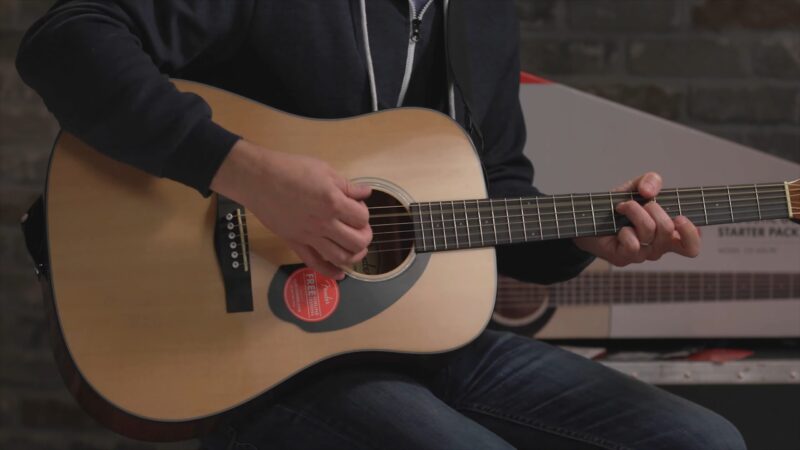
When you wear your guitar with a strap, it’s essential to find the right balance. Your guitar should neither be too low nor too high. Experiment with the strap length until you find the sweet spot where your guitar feels secure, and you can play without straining your wrist or shoulder.
As you find the perfect balance for your guitar’s position, consider experimenting with various chords, like the C minor chord, to enhance your musical expression.
Remember to distribute the weight of the instrument evenly between your shoulder and waist to prevent discomfort during long sessions. Practice sitting and standing with your guitar to get used to playing in different positions. This versatility can be particularly useful when performing on stage.
Tips and Tricks
Playing guitar with a strap can take a bit of getting used to, especially if you’re transitioning from playing while seated. Here are some tips to ensure you’re comfortable and confident while using your strap.
- Find Your Optimal Height: Experiment with strap length to find the perfect height for your guitar. It should rest comfortably against your body, allowing you to access all frets without straining.
- Balance the Weight: Distribute the weight of your instrument evenly between your shoulder and waist. This balance reduces the strain on your neck and shoulders during extended play.
- Practice Different Positions: Spend time practicing in various positions—sitting, standing, and even performing on stage. This versatility will make you a more adaptable guitarist.
How to Maintain Your Strap?
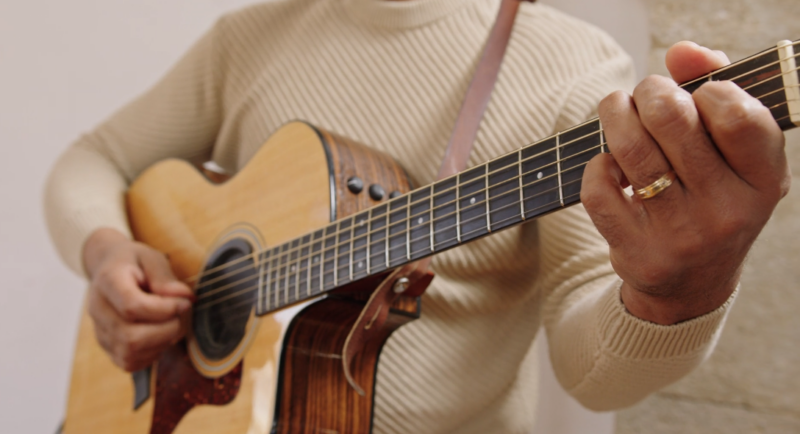
Taking care of your guitar strap is essential to ensure it remains reliable and comfortable. Depending on the material, clean your strap regularly. Leather straps may benefit from leather cleaner, while fabric straps can be hand-washed or spot-cleaned.
Regularly check your strap for signs of wear and tear, such as fraying or stretched holes. Replace it if you notice any issues to prevent accidents during performances.
Storage
When not in use, store your strap in a cool, dry place to prevent any damage from humidity or extreme temperatures.
Common Mistakes to Avoid
Even experienced guitarists can make mistakes when it comes to using straps.
1. Neglecting Adjustment
Failing to adjust the strap length properly can result in discomfort and poor playability. Take the time to find the right fit.
2. Overlooking Maintenance
Neglecting to clean or inspect your strap can lead to unexpected issues during performances. Regular maintenance is key to reliability.
3. Using Inadequate Straps
Using a low-quality or worn-out strap may not provide the support your guitar needs, leading to potential accidents.
FAQs
Can I use any strap for my acoustic guitar?
While you can technically use any strap, it’s essential to choose one designed for guitars. Guitar straps are designed with features like secure attachment mechanisms and width adjustments that make them suitable and comfortable for playing.
Can I attach a strap to my acoustic guitar without pins?
Yes, you can. There are alternative methods, such as using a shoelace or a string, to secure the strap to the headstock and bottom of the instrument.
What is the ideal strap length for a child learning to play the acoustic guitar?
For a child, the ideal strap length should allow the instrument to be positioned comfortably while sitting or standing. It’s typically shorter than the strap length for an adult. Measure the child’s body to determine the appropriate length, ensuring the guitar is easily playable.
Can I use a strap on a classical guitar as well?
Yes, you can. While classical guitars usually don’t have pins, you can attach a strap using alternative methods, like tying it around the headstock and attaching it to the lower bout of the instrument. Just ensure it’s secure and comfortable for your playing style.
Are there any specific maintenance tips for suede guitar straps?
Suede straps require a bit more care. To maintain them, avoid exposing them to moisture, as suede can stain and lose its texture when wet. You can gently brush the suede with a suede brush to keep it looking and feeling good.
Can I leave my strap attached to the guitar when storing it in a case?
It’s generally best to remove the strap from your instrument when storing it in a case. Leaving it attached can put pressure on the pins and the guitar’s body, potentially causing damage over time. Storing them separately is a safer practice.
Summary
In conclusion, attaching a strap to your acoustic guitar is a straightforward process that can greatly enhance your playing experience. Understanding the different types of straps, choosing the right one, and correctly attaching and adjusting them are essential steps for any guitarist.
With a securely attached and comfortably adjusted strap, you’ll be able to focus on making beautiful music without worrying about your instrument slipping or causing discomfort.
